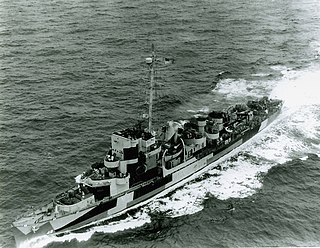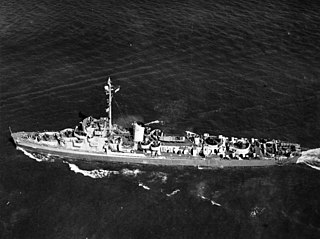
USS Schenck (DD-159) was a Wickes-class destroyer in the United States Navy during World War II. She was named for Rear Admiral James F. Schenck, USN (1807–1882).
USS Dallas (DD-199) was a Clemson-class destroyer in the United States Navy during World War II. She was the second ship named for Captain Alexander J. Dallas, and was later renamed Alexander Dallas.

USS Eldridge (DE-173), a Cannon-class destroyer escort, was a ship of the United States Navy named for Lieutenant Commander John Eldridge Jr., who led an operation for the invasion of the Solomon Islands.

The third USS Decatur (DD-341) was a Clemson-class destroyer in the United States Navy following World War I. She was named for Stephen Decatur.

USS Finch (DE-328) was an Edsall-class destroyer escort in the service of the United States Navy from 1943 to 1946 and from 1956 to 1969. From 1951 to 1954, she was loaned to the United States Coast Guard where she served as USCGC Finch (WDE-428). She was scrapped in 1974.

USS Holton (DE-703) was a Buckley-class destroyer escort in service with the United States Navy from 1944 to 1946. She was scrapped in 1974.

USS Fogg (DE/DER-57), a Buckley-class destroyer escort in service with the United States Navy from 1943 to 1947. She was scrapped in 1966.

USS Hayter (DE-212/APD-80) was a Buckley-class destroyer escort in service with the United States Navy from 1943 to 1946. In 1967, she was transferred to South Korea where she served as ROKS Jonnam until 1986.

USS Enright (DE-216/APD-66) was a Buckley-class destroyer escort in service with the United States Navy from 1943 to 1946. In 1967, she was transferred to Ecuador where she served until she was scrapped in 1989.

USS Daniel (DE-335) was an Edsall-class destroyer escort in service with the United States Navy from 1944 to 1946. She was scrapped in 1974.

USS Gilmore (DE-18) was an Evarts-class short-hull destroyer escort in the service of the United States Navy.

USS Dobler (DE-48) was an Evarts class destroyer escort constructed for the United States Navy during World War II. She was sent off into dangerous North Atlantic Ocean waters to protect convoys and other ships from German submarines and fighter aircraft. She performed escort and antisubmarine operations in battle areas before sailing home victorious at the end of the conflict.

USS Robert E. Peary (DE-132) was an Edsall-class destroyer escort in service with the United States Navy from 1943 to 1947. She was sold for scrap in 1967.

USS Blair (DE-147) was an Edsall-class destroyer escort in service with the United States Navy from 1943 to 1946 and from 1951 to 1960. She was scrapped in 1974. Blair was named in honor of Chief Machinist's Mate Eugene Blair, who was awarded the Silver Star posthumously for his brave actions when his ship was attacked and bombed by Japanese planes near Port Darwin, Australia, in mid-February 1942.

USS Martin H. Ray (DE-338) was an Edsall-class destroyer escort built for the U.S. Navy during World War II. She served in the Atlantic Ocean and the Pacific Ocean and provided destroyer escort protection against submarine and air attack for Navy vessels and convoys.

USS Enoree (AO-69) was a Chiwawa-class oiler constructed for the United States Navy during World War II. She was the only U.S. Navy ship named for the Enoree River in South Carolina.

USS Keith (DE-241) was an Edsall-class destroyer escort in service with the United States Navy from 1943 to 1946. She was scrapped in 1974.

USS Henry R. Kenyon (DE-683) was a Buckley-class destroyer escort in service with the United States Navy from 1943 to 1947. She was sold for scrap in 1970.

USS Pavlic (APD-70) was built by Dravo Corporation at Pittsburgh, Pennsylvania as a Buckley-class destroyer escort. Pavlic was launched 18 December 1943 and towed to Texas for refitting as a United States Navy high-speed transport. Pavlic was in commission from 1944 to 1946, serving in the Okinawa campaign as a radar picket ship. Pavlic was decommissioned 15 November 1946. After more than 20 years of inactivity in reserve, she was stricken from the Navy List on 1 April 1967. On 1 July 1968, she was sold for scrapping to North American Smelting Company.

USS Gherardi (DD-637/DMS-30), a Gleaves-class destroyer, is the only ship of the United States Navy to be named for Rear Admiral Bancroft Gherardi.



















